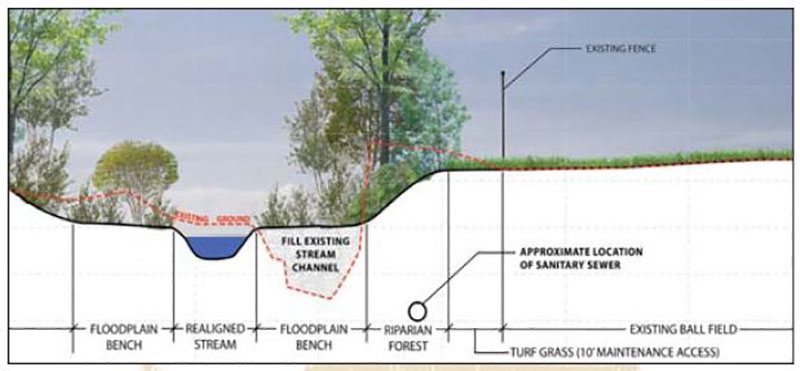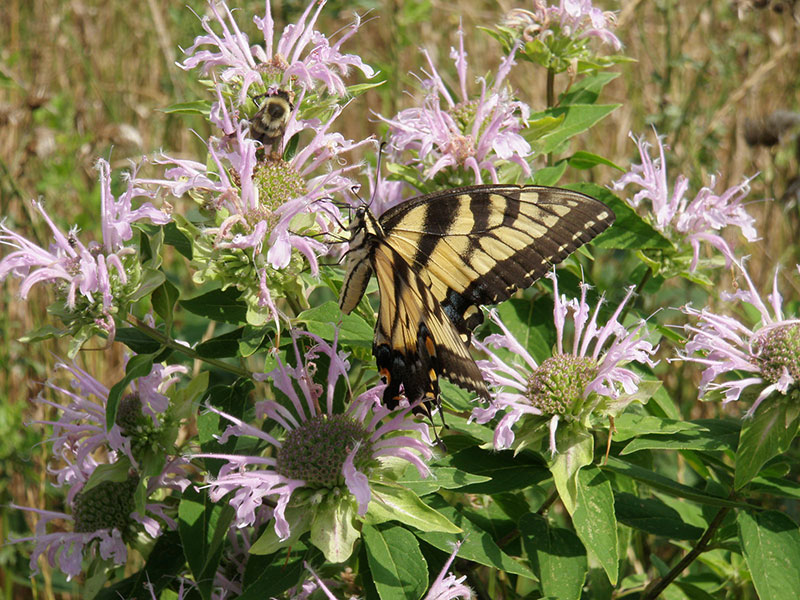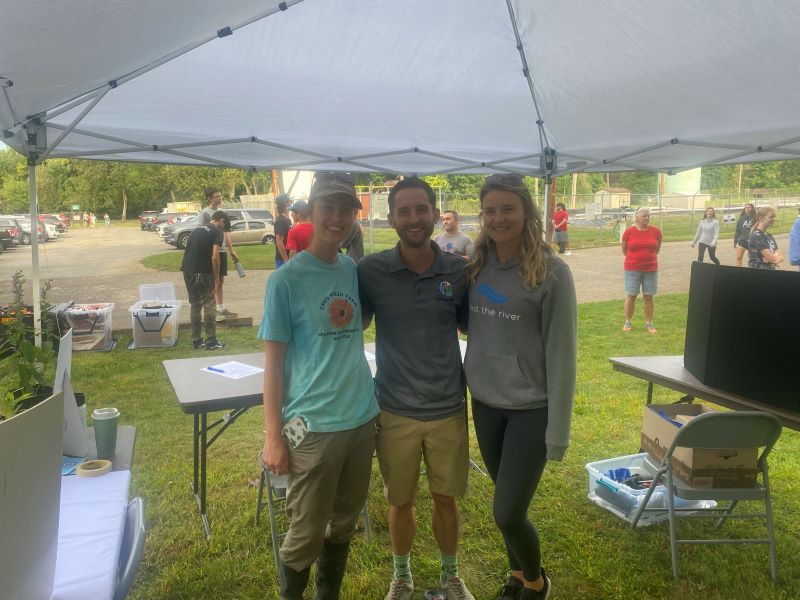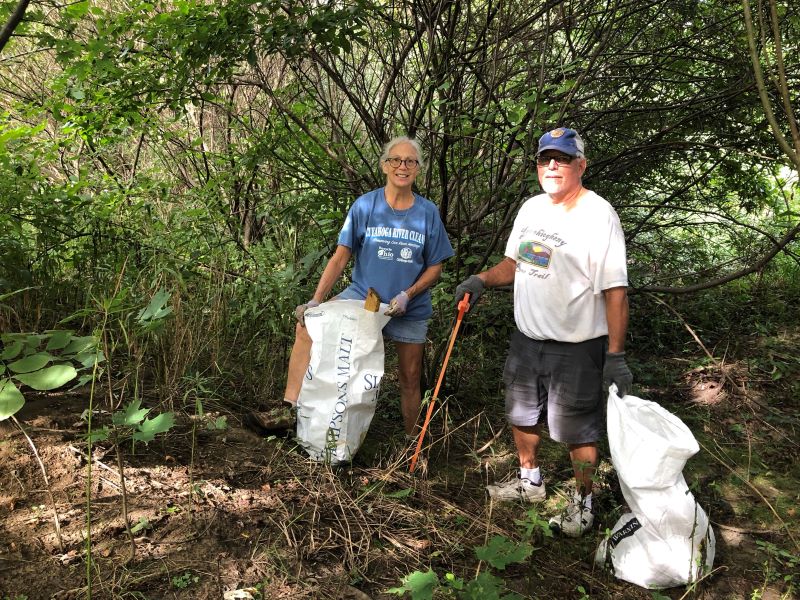
Growing up in the hilly forests of Northeast Ohio, I spent countless hours in the park systems within Cuyahoga Falls. In Waterworks Park, I would play in the bends of the Cuyahoga River and examine stones and bugs I’d find along its riffles and banks. In Kennedy Park, I’d watch my brother play baseball in the fields along Kelsey Creek, just upstream of its confluence with the Cuyahoga River. I would hike the Summit Metroparks Fall hiking spree every year. My parents even brought me as a baby. Growing up surrounded by beautiful natural spaces likely influenced my decision to study Environmental Engineering at The Ohio State University.
When I first started at Biohabitats and learned of the restoration at Kelsey Creek where I grew up, I was so excited to see it. I remembered the mowed banks that used to run directly to the Creek, and the extreme erosion from its banks that would cloud the stream for all of its inhabitants and worsen downstream water quality issues.
I wasn’t the only one who remembered this. Sandy Barbic, an educator with Summit Soil Water and Conservation District, recently shared her memory of watching a sediment plume flow from Kelsey Creek into the Cuyahoga River at one of their sampling sites during an educator’s workshop in 2013. “It poured during one of our workshops,” she said. “As it did, I noticed a plume of sediment entering the Cuyahoga. It was very striking and I thought it was a great photo opportunity to use as an illustration in our education programs about stormwater runoff.”
She then remarked about the difference restoration has made in the creek. “The Kelsey Creek restoration is a great story,” she said. “When we went back to that same site for more workshops after the restoration project, we could really see the difference in the flow into the river.”
I learned that those eroding banks were transformed by two projects designed and constructed by Biohabitats and Meadville Land Service. The removal of a downstream dam in 2009 led Kelsey Creek to downcut and lose connection to its floodplain, which then threatened utilities. The first restoration project in 2013 created a series of step-pools, constructed riffles, boulder toe protection, and bank stabilization features. The existing stream channel was filled and a new stream alignment was graded which reconnected Kelsey Creek to its floodplain. These features restored grade in the systems, which stopped high velocity flows from stripping away the banks while also creating habitat in the riffles, pools, and wood. Volunteers planted trees to finish the restoration, including a local couple named Nancy and Bob Henry.

The second project in 2017 added 1,000 more feet of restored stream, complete with cobble riffles and pools, and converted 1.7 acres of lawn to riparian forest and meadow. At the same time, an arboretum was established at Kennedy Park with educational signage throughout the project. I consider that signage to be an important part of the project’s success. You can add as many riffles as you’d like to a stream, but if a community is disconnected from the project and wants to mow down all of the plants and trees up to the bank, a successful restored project will be difficult to achieve.
As I walk along Kelsey Creek today I see a stabilizing ecosystem. I see healthy floodplain benches, stable banks, and an aggrading system where a natural amount of sediment drops out and feeds the system instead of bombarding the Cuyahoga River downstream. I see a maturing riparian buffer with native plants like bee balm (Monarda fistulosa), elderberry (Sambucus canadensis), and wild senna (Senna hebecarpa) supporting the pollinators and wildlife that depend on their native blooms.

But all is not restoration eutopia. I also see some patches of invasive lesser celandine (Ficaria verna) and honeysuckle (Lonicera macckii) moving in. I see the trees that are now 5-10 years post restoration being swallowed up and disfigured by their original plastic cages. I can’t stand it. I decide I will personally pull off each of the cages if I have to.
By chance, a friend of mine encouraged me to reach out to Cuyahoga Falls’ new Community Outreach Coordinator, insisting that we would quickly become good friends. Enter Bryce Pulley.

I reached out to Bryce and we began chatting about the Kelsey Creek restoration projects. We were both former teachers in earlier lifetimes, and Bryce listens to all of my excitement about the projects and responds with his own ideas about how to engage teachers and volunteers in a cleanup of Kelsey Creek. We formed a plan to host a volunteer cleanup day as a part of the Cuyahoga River Fall Cleanup Series, a series of events hosted by local Cuyahoga Falls businesses designed to educate volunteers about sustainability and stewardship of local Cuyahoga River sites. Bryce invited Sandy Barbic to share her knowledge of the site with volunteers.
We held the event in the fall of 2022. We had a great turnout of volunteers – 66 including members of a 10th grade Biology class who had been promised extra credit for their participation. Bryce coordinated with several local breweries (HiHO Brewing Company, Missing Mountain Brewing Company, and McArthur’s Brew House) to reuse their grain bags to gather litter. We ended up removing 500 pounds of litter and at least 100 tree cages, which were then reused by the City of Cuyahoga Falls’ Parks and Recreation Department to protect other trees. Bryce had explained to me that one of the goals of outreach initiatives like this cleanup and partnerships with local breweries is to instill the “reduce, reuse and recycle” ethos in the community in new and fun ways, and it was clear to me that we were doing that.
I was struck by one couple in particular – Nancy and Bob Henry. Nancy and Bob were at the original tree planting at Kelsey Creek in 2013 and they are back for the tree cage removal in 2022. They said they remembered what the creek looked like before it was restored, with its severely eroding banks and asked what fish species should be in Kelsey Creek now in its restored state.

To me, Nancy, Bob, and Bryce represent what a long–term, successful ecological restoration project looks like: residents who are invested their community, who keep coming back to volunteer and support their local streams, and who ask questions. Community coordinators who facilitate long-term stewardship of the area’s natural resources. It is the combined efforts of local watershed monitoring organizations, community organizers, volunteers, and all who just decide to care and commit to protecting and tending our communal natural areas that will lead to the restoration of these ecosystems and the functions and biodiversity they provide in the face of modern urban environmental challenges, and for their efforts, I am grateful.
